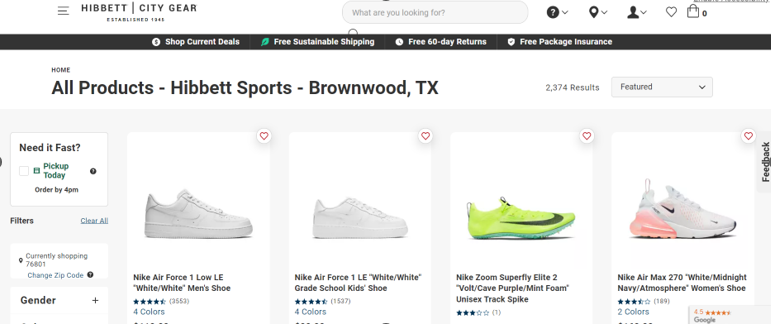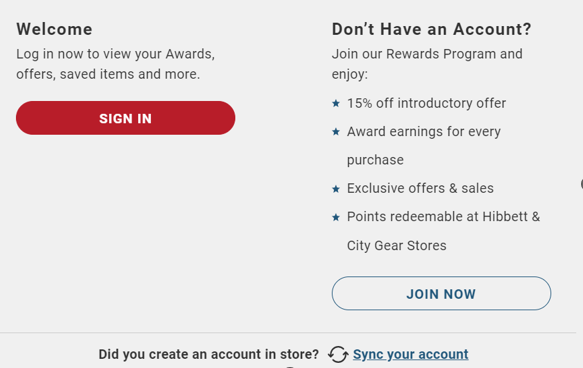
When Hibbett Inc. entered the e-commerce realm to sell its footwear and athletic apparel, the retailer certainly couldn’t claim a first- or even second-mover advantage. It was 2017, after all, a year by which most major retailers were well-established online.
But true to form, Hibbett rolled out its online presence with strategies that keep customers at the center of its business model, go against some conventional retail thinking, and maintain a major focus on its brick-and-mortar stores, which have continued to thrive alongside its growing online business.
A publicly held company, Hibbett earlier this month reported fiscal 2023 revenue of $1.7 billion from its 1,110 stores and online sales. E-commerce accounts for about $300 million in annual sales. The company operates in underserved, often rural markets.
In the 2015-2016 timeframe, Hibbett recognized it was losing sales of its premium footwear and apparel products to online sellers, which precipitated its e-commerce push.
“The primary need was, how do we give our customers the ability to purchase from us online?” says Bill Quinn, senior vice president of marketing and digital for Hibbett, based in Birmingham, Ala. “Part of the research was asking how much our customers are spending online because we’re in these smaller markets. The big finding was, they’re spending a lot.”

He adds: “The type of items we sell aren’t widely distributed, so you can’t get them everywhere. But the people who did carry those items, that’s who our customers were going to. We really needed to provide a solution to make sure that we weren’t losing our customers.”
Customer First
Hibbett prides itself on customer experience. It runs modest-size stores, roughly 3,500 square feet, with two or three staff members focused on delivering strong customer service. It’s not unusual for those staff members to know customers by name and reach out to them by phone when new products or sizes arrive. And to guide them through the store to ensure they find what they’re looking for.
“This is very different than walking into, say, a 50,000-square-foot retail establishment and trying to find someone or trying to find the products you’re looking for,” Quinn says. “The amount of friction we have in our day-to-day shopping environment is not high. That’s what we wanted to bring to life online.”
The company maintains that experience — and extends it across channels — in several ways:
- Making inventory available on the web at the individual store level
- Managing fulfillment directly from stores rather than on a centralized basis
- Providing full integration of its loyalty program online
- Personalizing the online experience through recommendations and other features
Each of these four elements of its strategy is broken down in further detail below:
Inventory Availability
From the day the online store launched in mid-2017, inventory was accessible to customers at the store level, with fulfillment carried out through the customer’s local store, Quinn says. “Customers can actually go to their local store online, search inside the store, navigate inside the store, and buy inside the store.”

Customers also have the option to reserve a product if they’re not prepared to make payment, so those that prefer to reserve online and pay in-store can do so. “It’s that lack of friction that we wanted to deliver on” for online customers, Quinn says.
Store-to-Customer-Fulfillment
A natural extension of making inventory viewable at a store level is the practice of fulfilling online orders directly from the customer’s local store. At the time that Hibbett launched its online store, local fulfillment was fairly unique, Quinn notes, but added that more companies have gotten on board. He says direct-from-store fulfillment has always been a strength of the company, and it has enabled Hibbett to build out related functions from an omnichannel perspective, such as buy online, pick up in-store (commonly referred to as BOPIS), as well as reserve online, pick up in store. The company is also now offering home delivery.
“Most of our customers are local, including our online customers who live near our stores. So when the store fulfills, that means we’re very close to our customers and we’re able to deliver a lot quicker as well,” Quinn says.
Fulfillment from stores was a boon during Covid shutdowns when the company was able to keep only 150 of 1,100 stores open, but it was still able to keep all employees working with a focus on fulfilling online orders. “We were able to service our customers but we were also able to take care of our employees which is very important to us,” he says.
Loyalty Program Integration
Quinn notes the top three factors when it comes to customer acquisition and retention for Hibbett: location, merchandise, and its loyalty program. From its 2017 inception, the full functionality of the company’s loyalty program was available to customers online, further extending the experience across channels to keep customers engaged and coming back. That’s important in an economy where brand loyalty is ever more difficult to maintain.
“Customers are going to be loyal to you up until they find a better experience, right? And so you want to always be pushing the boundaries on your customer experience and creating something new for the customers that’s really going to solve pain points,” he notes.

Personalized Recommendations
One way to push boundaries and resolve pain points is by personalizing the customer experience. As noted earlier, the in-store experience already includes a level of face-to-face personalization, in the form of relationships between customers and employees.
Hibbett is using artificial intelligence (specifically, Salesforce Einstein) to recommend relevant items to customers. AI functionality will identify alternatives (sizes, colors) if a preferred item is out of stock. AI also powers the company’s chatbot. “We’re happy with the containment; it answers a lot of questions so we don’t have agents answer those questions,” Quinn says. “We are big believers in AI.”

“As Hibbett Sports has done, the key is to focus first on the customer — putting the customer at the center of everything — and then making whatever changes you need to make internally to deliver on that. Business leaders should push very hard on their technology partners to ensure they’re fully aligned with that outlook.
Bob Evans, Cloud Wars founder and Acceleration Economy co-founder
Tech Underpinnings
As noted above, Hibbett is using Salesforce’s Einstein AI technology to power several customer-facing applications. That’s a subset of the company’s commerce infrastructure which is powered by Salesforce and, more specifically, Salesforce B2C Commerce.
I asked Quinn about the key factors behind the decision to go with Salesforce. He said Hibbett reviewed the top tier of commerce software providers and found Salesforce had “by far the best offering in terms of the SaaS E-Commerce platform…I would argue they still have an incredible SaaS offering.”
Key criteria on which Hibbett evaluated Salesforce and the other three to four top-tier SaaS offerings included product features, total cost of ownership, and whether they offered simple deployment that would expedite time to market. Ease of maintenance was also a major consideration.
“If you have something that’s highly complex to manage on a day-to-day basis, that will really limit your growth,” he says.
Innovation Focus
In fact, the company was looking to enable its team to dedicate 80% of its time to innovation and growth, and 20% to managing day-to-day functions. Hibbett has been able to support that objective, evidenced by continuing growth post-pandemic: the company’s e-commerce revenue grew 14% year over year in its fiscal 2023. These results encourage a continued focus on innovation.
That means trying new things and accepting failures that occur because you’re constantly learning and testing. Quinn exhorts companies to build and learn while engaging best-in-class partners. “Because of how we’re architected — and Salesforce being a big part of that — we’re able to focus on that growth,” he says. “Our batting average is nowhere near perfect on the stuff we’re testing, but it doesn’t have to be. The wins add up.”
Evans said companies need that growth focus. “There’s an eternal truth in Bill Quinn’s observation that ‘If you have something that’s highly complex to manage on a day-to-day basis, that will really limit your growth’,” Evans says. “And that truth is particularly timely today as complexity and distractions and friction — anything other than a beautifully optimized end-to-end operation — will limit a company’s ability to deliver superior customer experiences, no matter what channels you’re working in.”
To hear more data modernization, AI/hyperautomation, cybersecurity, and growth strategies from CIO practitioners, tune into Acceleration Economy’s Digital CIO Summit, which takes place April 4-6. Register for the free event here.










